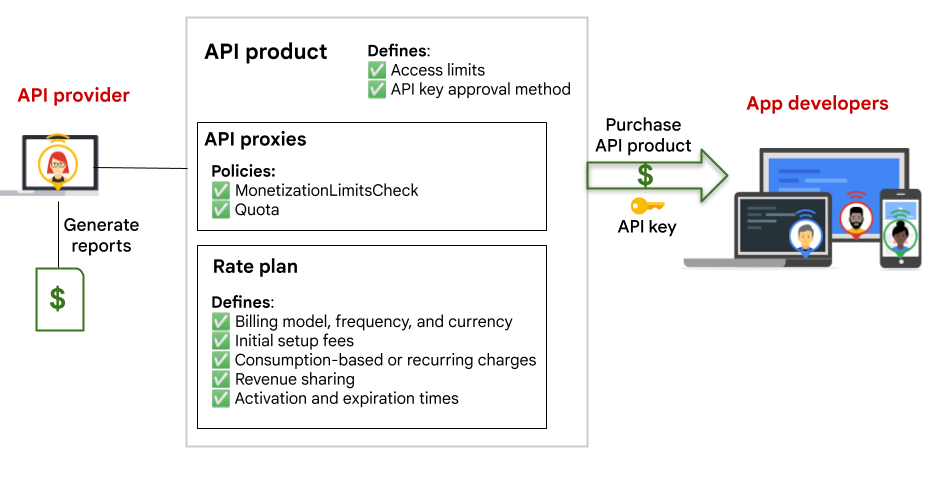This page applies to Apigee and Apigee hybrid.
View
Apigee Edge documentation.
![]()
This section introduces you to Apigee monetization.
Monetize your APIs using Apigee monetization
As an API provider, you need an easy-to-use and flexible way to monetize your APIs so that you can generate revenue whenever your APIs are used. Using Apigee's monetization feature, you can add a rate plan to an API product. The rate plan lets you charge the developers for using your APIs. You can also configure the rate plan to share your API revenue with the developers.

As an API provider you monetize your APIs by enabling Apigee monetization in your organization and configuring the components defined in the following table.
| Component | Description |
|---|---|
| API proxies | When developing API proxies for use with monetized API products, you can attach the following policies:
|
| API product | Define the collection of API proxies that you want to provide to app developers as a monetized bundle. The API product configures the access limits (quotas), API key approval method, rate plan (described below), and other details for the bundled API proxies. For more information, see What is an API product? and Enforcing monetization quotas in API products. |
| Rate plan | Define the billing configuration, fees, and charges that are incurred for the use of APIs offered in a monetized API product bundle. For example, you can share the API revenue with your developers. For more information, see Managing rate plans for API products. |
To enable app developers to purchase API product subscriptions, as an API provider you can do one of the following:
- Integrate Apigee monetization with your Drupal-based developer portal
- Build a custom portal interface and purchase and manage API products subscriptions using the API
To access APIs, app developers purchase API product subscriptions, add them to their apps, and obtain an API key to send with API requests.
Understanding monetization quotas
A quota defines the number of requests allowed for an API product over a given time period. Quotas can protect your backend servers from high traffic variances and differentiate your product line.
When creating your API products, you can configure business-level quotas to control access to your APIs. For more information about quotas defined at the API product level, see Quotas.
Attach Quota policies to the API proxies in your monetized API product to ensure that the quota defined at the API product level is used. For more information, see Enforcing monetization quotas.
Understanding billing
Apigee monetization supports both postpaid and prepaid billing accounts.
- Postpaid billing: In postpaid billing, your app developers do not make any upfront payment. App developers are billed after using your API products.
- Prepaid billing: In prepaid billing, app developers pay in advance
before using your API products. The upfront payment made by the developer is
available in the developer's wallet. Based on the usage, the per-transaction cost is
deducted from the wallet.
The setup fee (if any), per-transaction cost, and any recurring fees are deducted from the wallet. If the developer's wallet contains less than the amount of any setup fee at the time of the API product purchase attempt, the purchase will fail with an error indicating insuffient funds.
When creating a rate plan, you configure the billing currency and frequency, any setup and recurring fees, and the consumption-based fees. Based on the rate plan configuration and the developer's unique API key used to access your APIs, you can collect usage data for analysis and to generate monetization reports. Then, you can use the data collected to generate your billing invoices.
